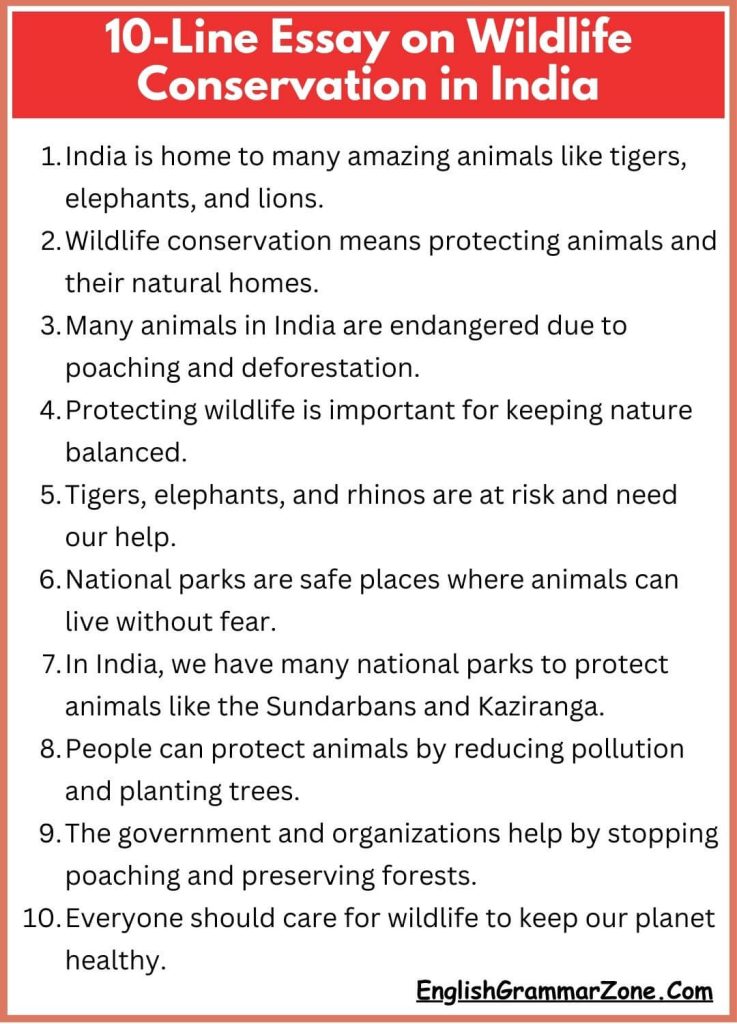Essay on Wildlife conservation in India is the practice of protecting animal species and their habitats to ensure their survival. In India, wildlife is not only diverse and unique but also plays an important role in maintaining the balance of nature. Sadly, many animals are at risk due to human activities like hunting, habitat destruction, and pollution. Conservation efforts are vital to safeguard the biodiversity of the country and the well-being of these animals.
In this article, we will learn how to write an essay on wildlife conservation in India in English (10-line essay, short easy & long essay for children).
10-Line Essay on Wildlife Conservation in India
- India is home to many amazing animals like tigers, elephants, and lions.
- Wildlife conservation means protecting animals and their natural homes.
- Many animals in India are endangered due to poaching and deforestation.
- Protecting wildlife is important for keeping nature balanced.
- Tigers, elephants, and rhinos are at risk and need our help.
- National parks are safe places where animals can live without fear.
- In India, we have many national parks to protect animals like the Sundarbans and Kaziranga.
- People can protect animals by reducing pollution and planting trees.
- The government and organizations help by stopping poaching and preserving forests.
- Everyone should care for wildlife to keep our planet healthy.

Short Essay on Wildlife Conservation in India
Wildlife conservation in India is about protecting animals and their habitats. India is home to many unique and endangered species like tigers, elephants, rhinoceroses, and various birds. These animals face threats from human activities such as deforestation, poaching, and pollution. Wildlife conservation aims to protect these animals from extinction and help maintain a healthy ecosystem.
India’s forests and national parks play a big role in wildlife conservation. National parks like Jim Corbett and Kaziranga provide safe places where animals can live and thrive. These parks protect animals from hunters and offer them a safe environment to grow and reproduce. Without such spaces, many animals would struggle to survive.
Tigers and elephants are iconic species in India that need special protection. Tigers are endangered, and their numbers are rapidly decreasing due to habitat loss and illegal hunting. Elephants, too, are at risk because of human-wildlife conflict and habitat destruction. To protect them, it is important to stop poaching, prevent deforestation, and educate people about the importance of wildlife.
To protect wildlife in India, the government has set up laws like the Wildlife Protection Act. Organizations and local communities also play a significant role in spreading awareness and taking action against illegal hunting. With combined efforts, India can continue to preserve its wildlife for future generations.
Long Essay on Wildlife Conservation in India
Wildlife conservation in India is the act of protecting wild animals, plants, and their habitats. India is a country rich in biodiversity, with more than 90,000 species of animals, including tigers, elephants, rhinos, and many unique birds. These animals play a vital role in the country’s ecosystems, which are essential for human survival as well. However, many species in India are under threat due to various factors like poaching, habitat destruction, and human-wildlife conflict.
India has a rich tradition of protecting animals. The concept of wildlife conservation is rooted in the country’s culture and religions, which often emphasize respect for nature. Despite this, India’s wildlife is facing severe threats. For instance, the Bengal tiger, the Indian elephant, and the one-horned rhinoceros are all considered endangered. These animals face dangers from hunting, habitat loss due to deforestation, and conflicts with farmers and villagers.
One of the most important ways to protect wildlife in India is by creating national parks and wildlife sanctuaries. National parks like Jim Corbett, Sundarbans, and Kaziranga are safe zones where animals can live without the fear of poaching or habitat destruction. These parks also help preserve the natural balance by providing a habitat for a variety of species, from the endangered Bengal tiger to rare birds like the Indian vulture.
The Indian government has taken several steps to protect its wildlife. The Wildlife Protection Act of 1972 was introduced to safeguard animals and plants. The Act makes hunting and poaching illegal and also established protected areas like national parks, wildlife sanctuaries, and biosphere reserves. Additionally, the government has set up special projects like Project Tiger to protect the Bengal tiger and Project Elephant to ensure the safety of elephants.
To conserve wildlife, it’s important to protect their natural habitats and prevent illegal hunting. It is equally important to raise awareness and educate people about the significance of wildlife. Communities can also play a vital role by reporting poaching activities and participating in conservation programs. Individuals can help by supporting sustainable practices, such as using less plastic, avoiding deforestation, and reducing pollution.
In conclusion, wildlife conservation in India is crucial for the country’s future. Protecting endangered species and their habitats ensures a balanced ecosystem and contributes to the overall well-being of the planet. Efforts from the government, local communities, and global organizations are all essential in maintaining the rich biodiversity that India is famous for. By working together, we can protect wildlife and their habitats for future generations.
Summary on Wildlife Conservation in India
“Save wildlife, save”life”—this saying reminds us how important it is to protect animals. India is home to a rich variety of wildlife, including tigers, elephants, and rhinoceroses. Many of these animals are endangered because of poaching, habitat loss, and pollution. To protect them, India has set up national parks and wildlife sanctuaries, which provide safe homes for these animals. The government has also introduced laws to prevent hunting and destruction of natural habitats. We must all work together to keep wildlife safe for future generations.

Frequently Asked Questions on Wildlife Conservation in India
-
Why is wildlife conservation important in India?
Wildlife conservation is important in India because the country is home to a wide range of unique and endangered species. These species contribute to the ecosystem’s health, which in turn supports human life. Protecting wildlife also helps maintain biodiversity, prevents soil erosion, and ensures that forests continue to provide resources like oxygen and water.
-
What are some endangered animals in India?
Some of the most endangered animals in India include the Bengal tiger, Indian rhinoceros, Asiatic lion, and the Indian elephant. These species are facing threats from poaching, habitat destruction, and human-wildlife conflict.
-
How do national parks help in wildlife conservation?
National parks provide protected areas where animals can live freely without the threat of poaching or habitat destruction. They help preserve ecosystems and allow endangered species to thrive in their natural environment. Parks like Jim Corbett, Sundarbans, and Kaziranga are essential for wildlife protection.
-
What steps is the Indian government taking to protect wildlife?
The Indian government has enacted laws such as the Wildlife Protection Act of 1972, which makes poaching illegal. The government has also set up protected areas like national parks and sanctuaries, and launched special projects such as Project Tiger and Project Elephant to ensure the survival of these species.
-
How can individuals help in wildlife conservation?
Individuals can help wildlife conservation by reducing their carbon footprint, supporting wildlife-friendly products, and spreading awareness. It is also important to report any illegal poaching activities and avoid supporting industries that harm the environment. Participating in local conservation programs can also make a big difference.
-
Why are tigers endangered in India?
Tigers in India are endangered primarily due to habitat loss, poaching for their skin and bones, and human-wildlife conflict. Efforts like Project Tiger have been launched to protect tiger habitats and reduce poaching, but much more needs to be done to ensure their survival.

